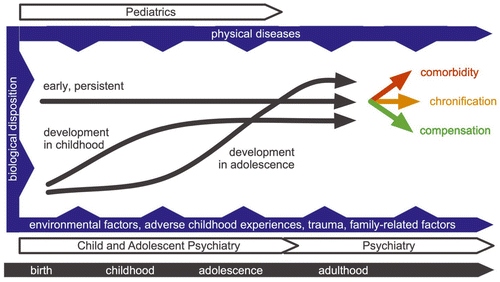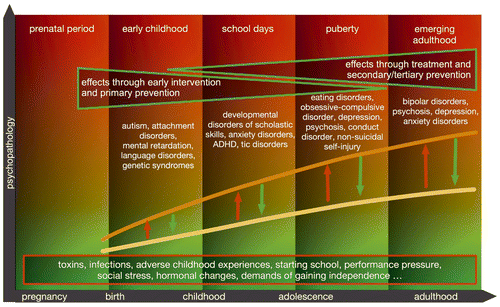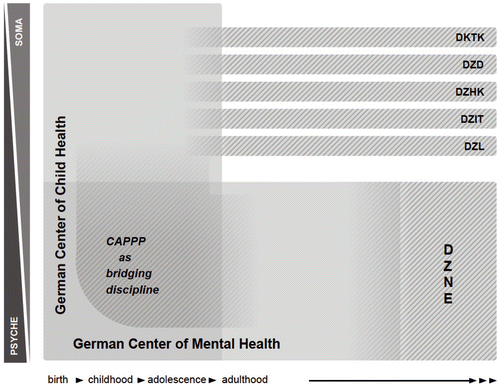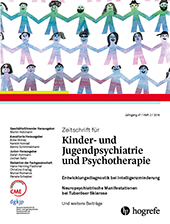On the Role and Significance of Child and Adolescent Psychiatry, Psychosomatics and Psychotherapy (CAPPP) Within the Planned National Health Centers
On September 6, 2018, the German Federal Ministry of Education and Research announced the foundation of two new German Centers for Health Research, to which Child and Adolescent Psychiatry, Psychosomatics and Psychotherapy (CAPPP) can make an essential contribution. Both centers will address widespread diseases that often begin in childhood and adolescence, can take a chronic course, and may lead to lifelong psychosocial disability.
Why Are the Two New German Centers for Health Research Necessary?
The tasks and objectives of the two new German Centers for Health Research were broadly outlined in the press release by the Federal Ministry of Education and Research (Bundesministerium, 2018). The funding program of the German Centers for Health Research focuses on improving the prevention, diagnosis, treatment, and care for widespread and frequent chronic diseases. In this respect, the recent press release prominently mentions mental disorders, especially behavioral disorders, anxiety disorders, and depression.
Prevalence and Early Onset of Mental Disorders
Mental disorders are at least as frequent as other widespread diseases but can be distinguished by the generally early manifestation of initial symptoms. Children, adolescents, and young adults alike are highly affected, resulting in considerable long-term negative impacts on the individual’s social, educational, and professional development as well as on family members. According to investigations by the World Health Organization (WHO) and the European Union (EU), mental disorders result in the greatest societal burden of all disease groups (European Commission, 2013, 2015; Wittchen et al., 2011; World Health Organization, 2004;). The degree of burden of mental disorders stems from their high prevalence (one in every two German citizens suffers at some point over their lifetime from a mental disorder), their generally early onset in childhood and adolescence (three in four begin before the age of 23), and – if left untreated – their mostly chronic course, precipitating numerous disease-related disabilities and limitations (Davis, 2013; Whiteford et al., 2015). In line with international trends, the ongoing increasing shift in morbidity from somatic to mental diseases can also be demonstrated among children and adolescents in Germany (Palfrey et al., 2005; Schlack et al., 2008). Questionnaire-based representative surveys revealed that around a one-fifth of all children and adolescents in Germany show symptoms of mental disorders in the form of emotional and behavioral problems (Baumgarten, 2018; Hölling et al., 2007; Hölling et al., 2014). Moreover, over 20 years of clinical-epidemiological studies have demonstrated that more than 20 % of all children and adolescents suffer from anxiety disorders, depression, and addictive disorders. In particular, the prevalence of affective disorders and addictive disorders in relation to digital media appears to be on the rise around the world (Mojtabai et al., 2016). Approximately 10 % of all boys and up to 20 % of all girls in Germany report suicidal thoughts, experience suicidal crises, or attempt suicide (Beesdo et al., 2015; Brunner et al., 2007; Kaess et al., 2011a, 2011b).
Nevertheless, in Germany, too, at least half of all people with mental disorders remain untreated by the healthcare system over their lifespan (Wittchen et al., 2011). Between 10-20 % of the affected children in Germany have contact with a therapist within 12 months of the initial manifestation of symptoms (Wölfle et al., 2014). According to WHO data, for example, for affective disorders, the treatment delay following first onset lies at 2 years in Germany (Christiana et al., 2000; Wang et al., 2007; Wittchen et al., 2011). Thus, initial specialist treatments generally only take place once comorbid diseases have already become manifest, when social disintegration is at an advanced stage and the respective disorder has become chronic.
Mental disorders cause 11-27 % of the overall costs of healthcare in Europe, while the additional indirect costs amount to many times this sum (European Commission, 2013a; European Commission 2013b; Gustavsson et al., 2011). Therefore, in its prognoses, the WHO emphasizes the increasing and special significance of mental disorders for the health of the population, as well as the associated costs for social-security systems (World Health Organization, 2004).
Age-Typical Courses of Development of Mental Disorders and Risks
Pathophysiological and therapeutic insights gained from adults cannot be generalized to children. Rather, it is essential to use multidimensional methods to examine the complex pathophysiological disease processes in these early phases of development in order to clearly improve the efficacy of development- and milieu-specific therapies and treatment forms.
Mental disorders show age-specific probabilities of occurrence and strongly age-dependent phenotypical expressions over the lifespan. While developmental disorders such as autism spectrum disorders, speech and language disorders, motor development disorders, or mental retardation are present from birth and early childhood – and are highly persistent – other disorders such as anxiety, depression, ADHD, conduct disorder, and developmental disorders of scholastic skills arise mostly over the course of childhood, and still others emerge predominantly during adolescence, such as eating disorders and substance abuse. Moreover, during adolescence, specific prodromal features of schizophrenic psychoses become apparent in thought, affect, and behavior, typically manifesting fully only in young adulthood (cf. Figure 1).

Furthermore, childhood and adolescence constitute a particularly critical period for brain maturation. Disruptions to a regular cognitive, social, and emotional neuronal development stemming from dysfunctional and impairing family patterns, traumatic events, or neglect of basic needs (so-called “adverse childhood experiences”) can considerably increase the risk both of initial manifestation and of particularly severe patterns of disease over the entire lifespan. More recent research has now identified especially critical, specific neurobiological and psychosocial developmental stages in childhood and adolescence which are seen as “critical time windows.” During these periods, the wheels can be set in motion to determine whether a lifelong vulnerability to mental disorders and a malignant course will arise - or whether resilience will increase and compensation will be successfully achieved (cf. Figure 2). For instance, starting or changing school, the onset of puberty, but equally the prolonged phase of adolescence into young adulthood (emerging adulthood) represent particular challenges that are associated with an increased risk of illness (Fegert, 2016).

Once a mental disorder has manifested in childhood and adolescence, the risk of developing comorbid mental disorders as well as consecutive somatic diseases rises considerably. Chronic somatic diseases, in turn, are associated with high rates of mental burden, and the comorbidity of somatic and mental diseases complicates progression and treatment (Haro et al., 2014).
While the complex and heterogeneous trajectories of mental disorders (see Figures 1 and 2) are better understood nowadays, this is certainly not the case for their determinants. Thus, it is currently barely possible to predict clinical courses (including the occurrence of comorbid diseases), the differential response to various therapeutic interventions, and the resulting treatment outcomes. Although modern research has led to the availability of many fundamentally effective therapeutic procedures, the question of which procedure is the best and most suitable one for which patient with which vulnerabilities and at which time point remains unanswered. Given the insufficient knowledge of specific risk signatures, and because of the lack of corresponding randomized controlled intervention studies, there is only a limited capacity to adapt current therapies and preventive measures in a risk- and need-appropriate manner.
Furthermore, children and adolescents are exposed to risks resulting from the large-scale off-label use of psychotropic drugs in childhood and adolescence and the development-specific particularities of pharmacokinetics and pharmacodynamics. Nevertheless, a professional and ethical requirement exists to offer and provide effective pharmacological and nonpharmacological therapeutic approaches to all age groups and with the necessary scope. Further research on interventions in the course of development aiming to avoid later diseases also demands a development-related ethical discussion regarding research in (still) healthy children and adolescents with the corresponding risk characteristics.
Thus, despite intensive efforts over the last few decades, from a therapeutic perspective most mental disorders are still not being sufficiently treated.
Better Understanding of the Causes of Mental Disorders
To improve treatment options, we must develop an awareness of the predisposing and triggering conditions as well as of pathophysiological mechanisms. The causes of mental disorders lie in the interaction between genetic predisposition, neurobiological manifestation, and modifying environment (cf. Figure 1). Adverse childhood experiences such as maltreatment, sexual abuse, and neglect affect around a third of the German population. The WHO assumes that 90 % of all cases are not adequately recognized and treated in the healthcare system. Therefore, besides the sustainable development goal on health (SDG 3), the international community has also set a specific goal of referring to children growing up free from violence (SDG 16.2) and corresponding indicators (Bundesministerium für wirtschaftliche Zusammenarbeit und Entwicklung [Federal Ministry for Economic Cooperation and Development], 2018). Such early stressors have considerable long-term impacts in terms of physical and mental health (Clemens et al., 2018).
However, the specific etiology and causal mechanisms involved in the development and maintenance of the respective mental disorders remain broadly unclear. The substantial technological and methodological advances in the areas of imaging, neuropsychology, neurophysiology, genetics, and epigenetics regarding the identification of the (neuro-)biological correlates of mental disorders still largely contrast, in terms of outcomes, the often-lacking specificity of these characteristics. Thus, there is still a lack of clinically applicable biomarkers that could improve the early identification of developmental disorders, and that could be utilized for early intervention strategies. Among other reasons, this stems from the diagnostic classification systems primarily defining mental disorders according to clinical symptoms. This diagnostic procedure neglects the substantial multifactorial and heterogeneous etiology and pathogenesis of the disorders. Following this line of thought, over the last few years, dimensional transdiagnostic multilevel approaches have increasingly been introduced into the research (research domain criteria) (National Institute of Mental Health, 2018).
The announcement by the German Federal Ministry of Education and Research of the establishment of a German Center for Child and Adolescent Health and a German Center for Mental Health (Bundesministerium, 2018) therefore takes reflects the urgent need to improve systematic translational research on the underlying pathophysiological mechanisms of mental disorders in order to improve prevention, diagnosis and treatment.
What Goals Can Be Defined Within the Two New German Centers for Health Research?
Several high-priority future challenges for research in the area of mental health are to be strategically pursued with structural and sustainable support in the framework of the new German Centers for Health Research. These tasks were developed within the EU-funded project “A Roadmap to Mental Health Research in Europe” (ROAMER) (European Commission, 2015) as the following “six research priorities”:
- 1Research on early prevention and intervention
- 2Focus on developmental aspects and causal mechanisms
- 3Use of international networks and databases
- 4Translation of new knowledge and technological procedures into treatment and prevention
- 5Reduction of stigma across the whole of society and promotion of participation among those affected
- 6Increased efforts in the area of care research
Prevention and Treatment in the Developmental Context
There is a need for a profound understanding of the complex causal mechanisms and their interaction with specific environmental stressors that determine the emergence, chronification, and development of comorbidities of mental disorders. Furthermore, the predictors of specific trajectories over the life course must be elucidated (ROAMER #2). Only then can we establish effective preventive, diagnostic, and therapeutic concepts in the early stages of development of mental disorders (ROAMER #1).
Building on widespread methodological and content-related innovations over the last few years, it is now necessary to generate and validate objectively testable models of pathogenesis and specific trajectory development. A special focus in this regard must be placed on early brain development, on critical periods of transition, and on the interaction of biological and psychosocial risks in various different settings (kindergarten, school, family). Biological model organisms (e.g., mouse, rat, zebrafish, cell model) can enable essential functional insights and must be complemented with the systematic exploration of developmental trajectories in longitudinal human cohorts. Both patient samples and population-based cohorts must be longitudinally tracked using multidimensional phenotyping strategies (deep phenotyping). This longitudinal approach is crucial to identifying early and development-specific risk and resilience factors, and to causally clarifying pathophysiological relations. Moreover, it should enable the development of age-specific preventive and therapeutic interventions and the investigation of their long-term effects into adulthood.
The traditional psychiatric diagnoses are not sufficient for the personalization of treatment. It is particularly important to validate psychosocial and (neuro-)biological predictors if we are to identify pathophysiologically defined subtypes of mental disorders, characterized by corresponding mechanisms of disease within the etiologically heterogeneous diagnostic categories. This etiological subclassification subsequently enables the improved prediction of individual courses of disease and treatment response. The results of longitudinal studies, the identification of causal mechanisms, and the establishment of clinically valid biomarkers in conjunction with psychosocial risk factors enables an increasing personalization (precision medicine) in the (psycho-)therapeutic care of patients with mental disorders (ROAMER #4). Above all, this includes the development and evaluation of age-adapted psychotherapeutic treatment methods in order to provide more specific, effective treatment methods in the future, with fewer side effects, to an increasing number of children and adolescents with mental disorders and their families.
At the same time, the increased risks to which children and adolescents are exposed because of the off-label use of psychotropic drugs (and likewise somatic drugs) in childhood and adolescence must be countered by the establishment of industry-independent platforms for clinical studies on the efficacy and (long-term) tolerability of psychopharmacological (and psychotherapeutic) treatment options for children and adolescents with mental disorders. In this respect, the expansion of pharmacovigilance research in childhood and adolescence is urgently warranted.
Research on the Interface Between Soma and Psyche
Longitudinal investigations are also essential regarding aspects of care research, for instance, when examining the effects of child-protection measures and the age-specific implementation of treatment guidelines (ROAMER #6). Likewise, large knowledge gaps exist regarding the longitudinal interaction between psyche and soma. Physical diseases such as cancer, atopy, or chronic-inflammatory bowel diseases can trigger psychological burdens culminating in secondary psychiatric morbidity. Likewise, mental disorders can lead to physical diseases (e.g., cardiovascular diseases, diabetes, obesity), and the medicinal treatment of mental disorders can further increase the risk of physical diseases. However, the recursive mechanisms are poorly understood. Structural support enabling longitudinal studies with accelerated designs by means of multiple cohorts which encompass an intelligent integration of existing cohorts can therefore create considerable synergistic effects between the two new German health centers from the perspective of developmental psychiatry and psychosomatics.
Methodological Innovations
Integrating data from different workgroups, national consortia, and international alliances into these centers is necessary in order to substantially increase the efficiency of research efforts. Networking data from consortia, databases, and registers using innovative methods presupposes expertise in Big Data technologies along with the corresponding statistical competence in networking within shared platforms and databases (ROAMER #3). The resulting integration of comprehensive multidimensional data and the application of data-driven classification approaches can lead to transdiagnostic pathophysiological models that supplement or, where applicable, revise the current clinical classification systems with relevant neurobiological and psychosocial biomarkers. Technological innovations (e.g., app-based medicine, telemedicine, virtual reality) are novel approaches for linking clinical, experimental, and real-life data – and for rendering research hypotheses amenable to ecological examination as well as providing opportunities to implement individually effective interventions into care.
Participation and Involvement
Because of the high vulnerability and special need for protection of children and adolescents, and especially of young patients with mental disorders, research on these age groups is subject to special ethical conditions, and in the case of research in minors, must always also include the subjects’ parents and families. The age- and illness-dependent capacity for consent must be assessed by experts on a case-by-case basis. Generally speaking, ethical and legal questions of preventive interventions stemming from research approaches that are already in practice at the animal experiment stage (i.e., interventions in still-healthy individuals) must be considered within the framework of the planned centers.
Questions related to restricting fundamental rights by means of freedom-restricting measures are being intensively discussed in the public domain and in the field. Over the past few years and decades, broad changes in thinking have taken place, with the afflicted and their families nowadays being granted considerably greater levels of self-determination and participation in the therapy processes. These aspects are especially sensitive in childhood and adolescence, and require not only a continuous ethical discourse, but also participatory approaches of care research in order to procure a more patient-based and objective evaluation of the effects of measures. In this context, CAPPP also assumes the role of an advocate for the concerns of children and adolescents with mental disorders and their families. It is committed to championing the involvement and participation of those affected in social and political life and in legal discourse as well as the normative development thereof (ROAMER #5).
The Role and Function of CAPPP in the Two New German Centers for Health Research?
There is clearly an urgent need for the foreseen structural and sustainable support of translational research in the area of the mental health, especially in the area of child mental health, in the form of two new German Centers for Health Research. Because of the high relevance of developmental psychiatric research themes, CAPPP shall assume a central role in the two new centers. Moreover, CAPPP shall act as a bridge in creating the desired synergies between the two German centers (cf. Figure 3).

Some essential structural characteristics emerge from the described future research tasks on psychological morbidity from a developmental psychiatric longitudinal perspective, as well as from the complex interaction between body and mind. These are reflected in the two future German Centers for Health Research:
- 1The interdisciplinary recruitment of new longitudinal and clinical cohorts of children, youths, and adolescents as well as the integration of existing databases will form the foundation for identifying causal mechanisms and developing etiology-based interventions, to enable the development of targeted and personalized interventions and the associated reduction of the burden of psychiatric morbidity across the whole of society. These interdisciplinary, longitudinal cohort studies can be synergistically applied to the two new German Centers for Health Research and thus constitute a “functional hinge” between the two.
- 2Both of the two new German Centers for Health Research should be urgently integrated into existing network structures within alliances of both university and nonuniversity facilities. To this end, particularly regarding childhood and adolescence, it is especially important to include a sufficient number of competent centers, as relevant samples can only be realized through alliances.
- 3The network structures should comprise facilities that, on the one hand, are already engaged in close interdisciplinary cooperations with competent partners from CAPPP and psychiatry/pediatrics; on the other hand, it is also necessary to include facilities whose specific child and adolescent psychiatric expertise proves essential for the conception of the two new German Centers for Health Research.
- 4In order to utilize and optimize synergies for the two centers mediated by CAPPP, interactive hubs are envisaged between the two new health centers, thus lending a structural foundation to this urgently necessary network.
In the translational dissemination and implementation of development-specific, evidence-based interventions and preventive measures, CAPPP can effectively translate scientific findings into widespread practice through close cooperative networking with school, teaching, youth welfare, and psychology. This will enable an effective reduction of the burden of mental disorders across the whole of society and over the entire lifespan.
Literature
(2018) Der Verlauf psychischer Auffälligkeiten bei Kindern und Jugendlichen – Ergebnisse der KiGGS-Kohorte. Journal of Health Monitoring, 3, doi:10.17886/RKI-GBE-2018-011, Robert Koch-Institut, Berlin.
(2015) The ‘Early Developmental Stages of Psychopathology (EDSP) study’: A 20 year review of methods and findings. Social Psychiatry and Psychiatric Epidemiology, 50, 851–866.
(2007) Prevalence and psychological correlates of occasional and repetitive deliberate self-harm in adolescents. Archives of Pediatrics and Adolescent Medicine, 161, 641–9.
Bundesministerium für Bildung und Forschung vom 06.09.2018 (Pressemitteilung) https://www.bmbf.de/de/startschuss fuer-zwei-neue-deutsche-zentren-der-gesundheitsforschung-6872.html (abgerufen 31.12.2018).Bundesministerium für wirtschaftliche Zusammenarbeit und Entwicklung . Agenda 2030 für nachhaltige Entwicklung. https://www.bmz.de/de/ministerium/ziele/2030_agenda/index.html (abgerufen 31.12.2018).(2000) Duration between onset and time of obtaining initial treatment among people with anxiety and mood disorders: an international survey of members of mental health patient advocate groups. Psychological medicine, 30, 693–703.
(2018) Association of child maltreatment subtypes and long-term physical health in a German representative sample. European Journal of Psychotraumatology, 9, 1510278.
(2013) Chief Medical Officer’s annual report 2012: our children deserve better: prevention pays. London: Department of Health. https://www.gov.uk/government/publications/chief-medical-officers-annual-report-2012-our-children-deserve-better-prevention-pays (abgerufen 31.12.2018).
European Commission (2013a) Brain Research supported by the European Union 2007–2012. A unique commitment 1,268 projects. Brussels. http://ec.europa.eu/research/conferences/2013/brain-month/pdf/publication_emob.pdf (abgerufen 31.12.2018).European Commission (2013b) Sixth FP7 monitoring report (monitoring report 2012). Brussels. http://ec.europa.eu/research/evaluations/pdf/archive/fp7_monitoring_ reports/6th_fp7_monitoring_report.pdf (abgerufen 31.12.2018).European Commission (2015) ROAMER – A roadmap for Mental Health Research in Europe. Final report summary. https://cordis.europa.eu/result/rcn/171328_de.html (abgerufen 31.12.2018).(2016) Übergang zwischen Jugend- und Erwachsenenalter: Herausforderungen für die Transitionspsychiatrie. Eckpunktepapier von DGKJP und DGPPN. http://www.dgkjp.de/stellungnahmen-positionspapiere/stellungnahmen-2016/396-uebergang-zwischen-jugend-und-erwachsenenalter-herausforderungen-fuer-die-transitionspsychiatrie (abgerufen 31.12.2018).
(2011) Cost of disorders of the brain in Europe 2010. European Neuropsychopharmacology, 21, 718–779.
(2014) ROAMER: roadmap for mental health research in Europe. International Journal of Methods in Psychiatric Research, 23 Suppl 1, 1–14.
(2007) Verhaltensauffälligkeiten bei Kindern und Jugendlichen. Bundesgesundheitsblatt – Gesundheitsforschung – Gesundheitsschutz, 50, 784–793.
(2014) Psychische Auffälligkeiten und psychosoziale Beeinträchtigungen bei Kindern und Jugendlichen im Alter von 3 bis 17 Jahren in Deutschland – Prävalenz und zeitliche Trends zu 2 Erhebungszeitpunkten (2003–2006 und 2009–2012) Ergebnisse der KiGGS-Studie – Erste Folgebefragung (KiGGS Welle 1). Bundesgesundheitsblatt – Gesundheitsforschung – Gesundheitsschutz, 57, 807–819.
(2011a) Explaining gender differences in non-fatal suicidal behaviour among adolescents: a population-based study. BMC Public Health, 11, 597.
(2011b) Childhood Experiences of Care and Abuse (CECA) Validierung der deutschen Version von Fragebogen und korrespondierendem Interview sowie Ergebnisse einer Untersuchung von Zusammenhängen belastender Kindheitserlebnisse mit suizidalen Verhaltensweisen. Zeitschrift für Kinder- und Jugendpsychiatrie und Psychotherapie, 39, 243–252.
(2016) National Trends in the Prevalence and Treatment of Depression in Adolescents and Young Adults. Pediatrics, 138, e20161878.
National Institute of Mental Health , https://www.nimh.nih.gov/research-priorities/rdoc/index.shtml (abgerufen 31.12. 2018).(2005) Introduction: Adressing the Millenial Morbidity – The Context of Community Pediatrics. Pediatrics 115: 1121–1123.
(2008) Die Gesundheit von Kindern und Jugendlichen in Deutschland – Daten aus dem bundesweit repräsentativen Kinder- und Jugendgesundheitssurvey (KiGGS). Umweltmedizin in Forschung und Praxis, 13, 245–260.
(2007) Delay and failure in treatment seeking after first onset of mental disorders in the World Health Organization’s World Mental Health Survey Initiative. World Psychiatry, 6, 177–85.
(2015) The Global Burden of Mental, Neurological and Substance Use Disorders: An Analysis from the Global Burden of Disease Study 2010. Plos One, 10, e0116820.
(2011) The size and burden of mental disorders and other disorders of the brain in Europe 2010. European Journal of Neuropsychopharmacology, 21, 655–79.
(2014) Somatic and mental health service use of children and adolescents in Germany (KiGGS-study), European Journal of Child and Adolescent Psychiatry, 23: 753–764.
World Health Organization (2004) The global burden of disea- se: 2004 update. http://www.who.int/entity/healthinfo/global_burden_disease/GBD_report_2004update_full.pdf (abgerufen 31.12.2018).



